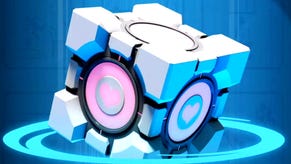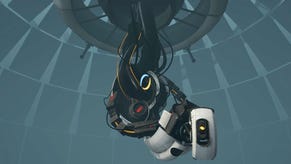Portal 2
Holesome.
Although the developer will always be known as the house of Half-Life, it's Portal that increasingly looks like the quintessential Valve game. It's both clinical and funny, like a shaggy dog story told by Stanley Kubrick, and its complex folds wrap geography and narrative together so tightly that they become two sides of the same object. Its ingenious puzzles are peculiarly action-packed, and if Gordon Freeman's adventures served to make realistic physics an indispensable part of modern videogames, the GLaDOS saga shows you the fun that can be had with entirely bizarre physics, too.
On the surface, then – and surfaces are always a tricky proposition with this particular game – creating a sequel to Portal sounds a little like creating a sequel to the Rubik's Cube: why bother when the blend of form and function already seems insurmountably balanced?
Valve responded to this concern at its E3 presentation last summer, of course. Portal 2 will add more stuff: featurey kind of stuff like co-op, which we'll get to later, and mechanical stuff like gels that boost your speed or send you bouncing through the environment, tractor beams, and trans-portal physics allowing you to thread air currents from one part of the room to the next. During a recent chance to play through the single-player campaign's opening, however, not much of this kind of thing was on display, but that only served to illustrate the point that a sequel to Portal is already on pretty safe ground, if only for the sole reason that the basic game is so clever and engaging that more of it is inevitably a good thing by itself.
Portal may have hinged on one central joke, but it was a brilliant one, contingent on the ugly collision between nasty intentions and the sterile euphemism that passes for speech within large corporations. Portal 2 quickly proves there are more laughs to be wrung from this during a cheerfully brutal opening sequence, which has Chell waking up, seemingly in a motel room, and being put through some basic orientation tests. Hundreds of years pass, everything goes creatively haywire, and she's dumped back into the Perspex cell in which she started her last adventure.

It's astonishingly slick stuff: an endless stream of uncomfortable witticisms undercutting apocalyptic spectacle, as Chell's prison starts to fall apart around her while the designers bury a basic movement tutorial under quips about art appreciation and brain damage. It serves to make you feel right at home from the very start.
But although the basic structure of picking your way through devious and deadly test chambers with the aid of a transdimensional hole-punch remains largely the same as it ever was, even early on in the sequel much has changed. For one thing, time has not been kind to the labs, and the stark and frosty gauntlets you ran in the first game have deteriorated into a spooky mass of rubble, twisted girders, and hanging creepers.
This being Valve, however, the environments are a lot busier but they're still just as readable, with those matte white tiles quietly guiding your eyes to useful spots, and a pinch from Left 4 Dead allowing you to see the placement of existing portals as glowing on-screen icons regardless of whether you're in a different room or not.








